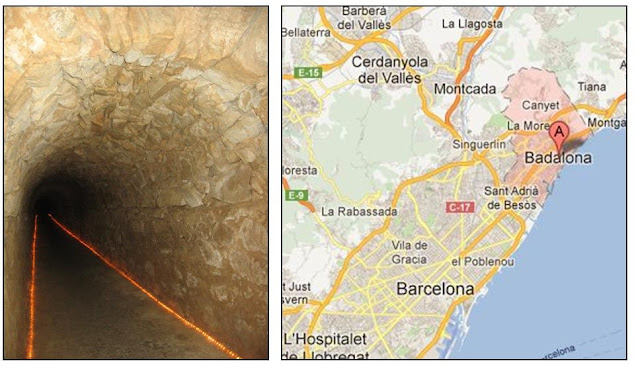 |
| The aqueduct at Badalona, Spain, with location map |
 |
|
Left: The Eifel aqueduct near Cologne showing vaulted roof and inspection manhole. Right: cross section of typical aqueduct at Lyon showing vaulted roof, foundations and cement lining of channel. Illustrations from Roman Aqueducts & Water Supply by A. Trevor Hodge (1992).
|
From the archaeologist I also have the following information. That no conservation work has been done – the duct’s perfect state of preservation is exactly as it was at the time of its discovery in the 1970’s. That it was located under one of the streets that ran from north to south (known as cardines). That it is presumed to have brought water to the town of Baetulo from the lower part of the Coastal Range. (Not sure what that makes the total distance - 25km perhaps.) That it was built in the early years of the reign of Tiberius and in use until the end of the first century AD. (So that's from c. 20 AD to c.100 AD. How do they know these things with such precision I wonder? Moreover it struck me as a remarkably brief period of use, requiring some sort of explanation, though the archaeologist didn't actually agree.)
Due to the steepness of the streets, the duct had a 7% fall, but a pavement of opus signinum (a tough type of mortar) prevented erosion of the duct. (According to Trevor Hodge, 1.5% to 3% was the usual gradient, anything steeper causing excessive erosion.)
They know about a stretch of 96 meters in all, the rest of the duct having disappeared due to modern construction work.
The duct has a width of 1.30 m and its maximum height is 1.50 m. The roofing system is a barrel vault with identical construction to the walls. Pepita Padrós is the archaeologist who has supplied all this information and many thanks for her trouble.
I very nearly missed the whole thing. The signage is poor. Not to put too fine a point on it, it's nonexistent. I was pondering a manhole in the street and a scruffy looking garage door when a man approached me, asked if I wanted to see the aqueduct and opened it up for me and led me down some steps.
 |
| Gaining access to the aqueduct |
I'll need to visit this aqueduct again, and I think there's a good chance. Badalona where we stayed is a suburb just north of Barcelona, with a good metro link, hotel right next to the beach, perfect in every way. Can give recommendations if you ask.
Nice little article here.
ReplyDeleteIt's a shame we locals don't give it the true value it has.
Note Badalona is not a suburb, but a city on its own, and with a very ancient history, I might add.
Come back any time!